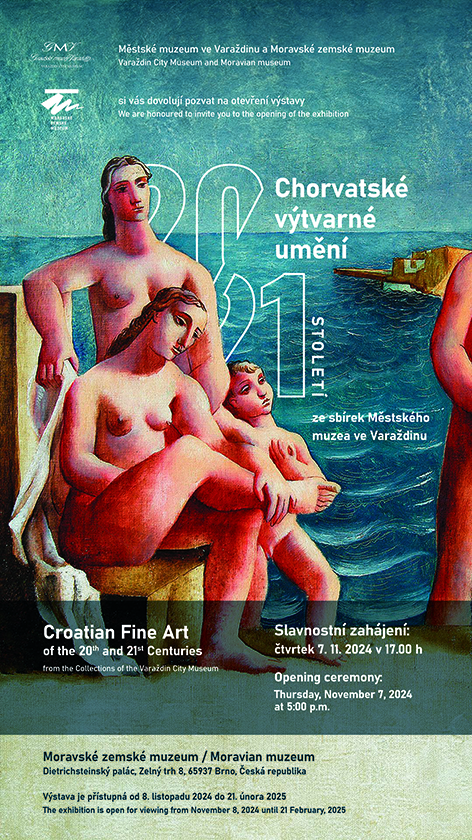from the Collections of the Varaždin City Museum
Moravské zemské muzeum
Dietrichsteinský palác, Zelný trh 8, Brno
7.11.2024. /21. 2.2025.
The aim is to highlight the overview of Croatian fine art of the 20th and 21st centuries with the exhibition, and to introduce the Czech art public to the values and achievements of the Croatian fine art scene. The works (paintings and sculptures) of the most important Croatian artists from the holdings of the Varaždin City Museum will be presented. They mark the key points of the development of Croatian art on its one-century journey and their strong links within the framework of the European context. At the same time, it is a brief overview of the latest currents in Croatian contemporary art. Each work speaks for itself about the continuity, the spirit of the times and the maturity of our artists, who, in terms of quality and style, rival their respected European colleagues.
Concept
The exhibition is divided into four segments:
Czech professor and his student / Vlaho Bukovac and Ivo Režek
The introductory part of the exhibition points to the intense ties that the Croats had with the Czechs, many intellectuals, especially artists, acquired their knowledge in Prague. We present one of the greatest Croatian painters, Vlaho Bukovac, who worked as a professor at the Academy of Fine Arts in Prague from 1903 until his death in 1922. He came to Prague precisely at the persuasion and invitation of his colleague from the Parisian student class, the Czech painter Vojtĕch Hynais, who was his lifelong friend. Among his students, the Varaždin painter Ivo Režek stands out, who received his first lessons at the Academy in Prague. The city’s spirit and atmosphere shaped his stylistic expression towards Neoclassicism, of which he was the most prominent representative.
The first half of the 20th century
At the turn of the nineteenth century into the twentieth century, Croatian painting experienced a boom. Radical changes took place in relation to traditional frameworks, thanks to young talented artists trained in European cultural centres (Vienna, Munich, Berlin, Paris, Milan, Venice and Prague). Led by Vlaho Bukovac, they turn to the modern expression and are the backbone of the beginnings of our Croatian “Modern. In terms of stylistic movements for the first time, although on the periphery, its representatives were paralleling the European ones. The beginning of the century was marked by Art Nouveau and Symbolist echoes (V. Bukovac, O. Iveković, E. Vidović). It was followed by an extremely productive period of new realisms: magical, neoclassicism and critical (M. Kraljević, M. Uzelac, V. Becić, Lj. Babić, I. Režek, O. Mujadžić), as well as the period of expressionist influences (O. Herman) and the intense colouristic period of the so-called “Coloristic Cézanism” (V. Filakovac, M. Tartaglia).
The second half of the 20th century
The years after the Second World War also symbolically liberated art. It was the freedom of individual expression and the pluralism of styles, building on avant-garde trends in Europe. Croatian artists join international abstract trends, looking for sensibility in organic abstraction, abstract expressionism, Art Informel. An impressive number of artists of that period individualized their expression with latently present expressionism, figuration and realism, not as stylistic components but as a spiritual and experiential constant, as well as an engaged and humane relationship to reality (Š. Perić, E. Murtić, F. Kulmer, M. Stančić, O. Gliha, Lj. Ivančić, S. Šohaj, Đ. Seder, N. Kavurić-Kurtović).
The beginning of the 21st century
An extremely large number of artists work in various segments of contemporary artistic practices. We single out only those related to painting and sculpture, or just few of them who actively participate in shaping the art scene of Croatia and the world: Z. Vehabović, D. Rogina, M. Zeman, S. Macolić, G. Kovačić Macolić, Z. Kopljar, A. Kos.
